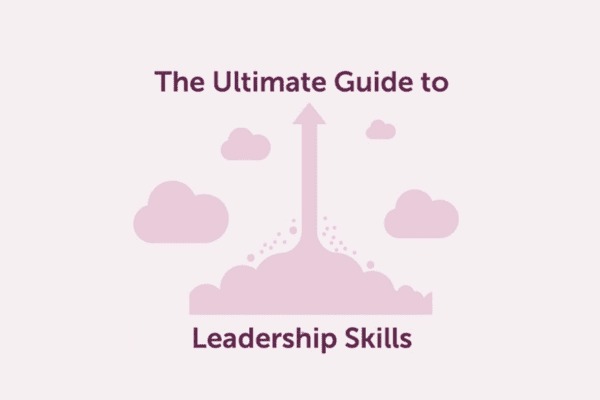Mastering Influence, Captivating Minds, and Achieving Unprecedented Success
In the modern-day workplace, the days of an authoritarian leader pounding on the desk while workers abide are happily no more. However, this has resulted in experimental ideas on the best way to influence people and decisions in the workplace. Now this is where influencing skills come into play.
Just consider for a moment, a charismatic gentleman who turns on the charm at will. Or even a stock replenisher working the night shift at a grocery store. Both can benefit from better skills in influencing. Wouldn’t you agree?
In this Ultimate Guide, we solve the mystery of how to influence others and persuasion skills. Additionally, we aim to improve your influencing and negotiation skills training. After all, there is no use in data and ideas unless you can use them in the real world. And our unique influencing skills tips will help you improve the most necessary communication and persuasion skills.
Even more, you will also understand influencing skills and techniques, determining how best to adapt your style. In fact, this information has a profound effect. It can improve your connection with employees, co-workers, and personal relationships. Moreover, it can help you recognise when you are BEING influenced. So, are you ready?

This Ultimate Guide will Cover:
- What is Influence? Influencing Skills Definition?
- What are Skills in Influencing and Techniques?
- Why Do I Need Influencing Skills Training?
- Why are Skills in Influencing Important?
- What are Influencing and Negotiation Skills?
- What are the Six Sources of Influence?
- How Do You Demonstrate Skills in Influencing?
- What is Your Influencing Style?
- What is the Ability to Influence Others?
- How Do You Influence Others?
- How Should You Influence at Work?
- Four-Step Method to Influence Others at Work
- What Influence is Important in Leadership?
- How Can I Tell if Someone Is Trying to Influence Me?
- How Persuasion Skills Relate to Influence
- What Improves Your Influencing and Persuasion Skills?
- Why We Fail to Influence
- Negative Ways of Persuasion and Influence
- How Can You Gauge Your Level of Influence?
- So, How Do You Improve Your Level of Influence?
- The Future of Skills in Influencing
- Summary and Key Insights
- Further Reading and Resources
1) What is Influence?/Influencing Skills Definition?
According to the Cambridge English Dictionary, how to influence others is the power to affect people or things. Now, though we associate influence with power, you don’t need to be a leader to have power or to be able to influence others within an organisation.
For instance, persuading others to support an idea, or a project, giving help or showing approval are just a few examples of skills in influencing and negotiation skills training. Certainly, persuasion is an important technique and skill which we will also cover further in the guide.
Utilising the Skills
Furthermore in this guide, we will identify why most people fail to utilise their influence and persuasion skills. In fact, they do the exact opposite of effective influence, without even knowing it! Luckily, we help you uncover your level of influence and become more transformational in your approach.
Lastly, we know you want real ways to improve your skills in influencing and persuasion. Therefore, we give you a simple method on how to influence others, one you can apply immediately. This vital information will help you get started with positive influencing and negotiating skills training today.
Workplace influencing and persuasion skills encourage the capability to accomplish work through others. From the top down, a leader will look to influence an entire company through their vision. Jack Welch, former CEO of General Electric is an example of a great visionary.
Yet, a person in customer service will also look to influence others too. They may, perhaps, influence a coworker in the warehouse, for example. Both individuals are making an impact and implementing practical influencing and negotiating skills training.

The Mystery of Influence
Influence is mysterious because it involves subtly changing another person’s mind or outcome. Specifically, it uses psychology, communication, and interpersonal skills to influence others. Also, when you have a grasp on what it is and how it is used, then you begin noticing it everywhere. Undoubtedly, the more aware you are, the better your negotiations, decisions, and relationships will be because you will understand what is influence.
2) What are Skills in Influencing and Influencing Techniques?
Influencing skills and techniques are the ability to get people to do something you want them to do. This might be just seeing your point of view or taking an action, or sometimes getting them to do nothing. Actually, we will cover how to influence others shortly.
If you believe that skills in influencing and techniques involve a big smile, lots of compliments and a sales pitch, then think again. Actually, skills of influence are matched to the root functions of influence. We know that influencing skills and techniques are learned traits. Babies are not born influential. Therefore, we can all improve in this area.
Companies want you to have to negotiate and influence others’ skills training but can’t pinpoint what that means in the scope of the job. So while reading the essential qualities below, think about the times when you used those same skills to influence others.
Note some leaders do not get high marks in all qualities of their skills. In fact, many seasoned leaders do not fully deliver all seven skills and capabilities.
There are 7 Key Qualities of Influencing Skills and Techniques:

- Appreciate others.
- Make quality decisions.
- Be clear in your message.
- Engage the audience.
- Give and receive feedback.
- Solve Problems.
- Be innovative.
Yes, You Are Influential!
The assumption that influence is synonymous with authority is no longer true.
Fortune Magazine’s annual issue of the 50 Greatest World Leaders is a shining example of influencing leaders. The accolades are not limited to CEOs and industry leaders. Instead, it celebrates individuals that are doing amazing work with or without formal authority.
It is motivating to read about people making a big impact. In fact, those celebrated could be retail cashiers taking on civil rights liberties and getting the support of others. Or the founder of a company influencing a movement for equal pay.
The more companies celebrate these change-makers, the more media reports on it. And this promotes people to act on ideas and work together.
These acts of influence don’t require saving whales or grand gestures. Everyday acts can hold as much value and benefit to some.
Communication and Influencing Skills Examples (Personal Influence):
Your child wants to watch a late-night TV show. She knows her audience (her mother) is concerned she will be tired the next day. She states logical reasons for wanting to watch. That is, it is the season finale and it will not play again. The mutual benefit is shown; time spent together. She picks up nonverbal cues of hesitation from the parent. In a reminder of credibility, she states her perfect record for never being late to school. The child has influenced the mother and is now watching the show.
Communication and Influencing Skills Examples (Professional Influence With Authority):
Charles is a new manager at Buy Now Foods with ten years of past grocery experience. He came to this job from a mid-sized market. Charles has been in the grocery game for ten years. He instantly sees some clear mistakes in the layout of the new store. So Charles explains the problems that he sees to the Owner. To his surprise, the ideas are shot down. Charles is dismayed. He was hired for his expertise and is now questioning the move. But Charles could have improved his odds of success had he used the four-step influence method of influence.
Related reading: Improve Your Communicating and Influencing Ability.
Other Persuading Skills and Influencing Skills Examples:
More examples of skills in influencing are of The Shark Trust, who changed the homepage of their website to say:

They then provided an infographic detailing the average annual deaths by animals in the United States. It showed that, in fact, sharks only account for 1 death per year. Whereas, deer and flying insects were responsible for 120 and 58 deaths respectively. In doing so, they were attempting to influence visitors to be less afraid of sharks.
3) Why Do I Need Influencing Skills Training?
The world now recognises influencing skills training as a benefit regardless of location or position. This is why our influencing skills training can really help forward your skills on this matter.
Furthermore, more organisations are adopting a model of shared leadership. The workload and functions are getting too large for influencing leaders and managers. They are more apt to hand over a project to someone that displays confidence and influence.
This also provides an opportunity for non-leaders to show their abilities which may have been confined by their role. Now more than ever, leaders can promote real change and impact a larger audience.
Global organisations prompt individuals to collaborate with people from different backgrounds, cultures and ethics.
So, if a person leans on their consistent practice of the four steps to influence then they are:
- Better able to assess the needs of customers, suppliers, and others they want to influence.
- Able to take an assertive position on a topic or promote an idea with logical reasons.
- Able to address and lead people across global organisations.
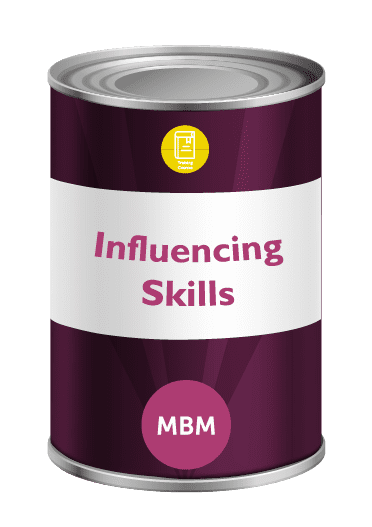
4) Why are Skills in Influencing Important?
If you influence people you can achieve anything. Imagine if you had the skills of persuasion to enable someone to buy, someone to vote, someone to see your perspective, someone to love, someone to care… Through the skill of influencing others, you can change the behaviours of others to achieve your goals. So check out our influencing skills training.
Continue reading to discover some of our best influencing tips.
How Can Improving My Skills Really Help Me?
Soft skills are now the backbone of many job descriptions. Influencing, persuasion and communication skills cannot be overstated to advance professionally. Human Resources and hiring managers actively pursue candidates with certain keywords indicating influence. Also, companies understand that these skills are a return on their investment.
Six Steps to Leading With Influence
Like many career-minded individuals, you may ask yourself ‘how can I become more powerful in my job?’ All in all, people want to advance in their careers, be seen by influencing leaders as more business-minded and be considered for future roles.
Below are some influencing tips to increase your power and influence, starting today! (communication and influencing skills examples):
- Develop your skills and ability to show your vision to others: you might have great ideas but getting others to see the big picture as you do can be difficult.
- Strategic thinking: know how to make plans, which variables are important, and how to solicit feedback.
- Persuade others: it is time to assemble a team and get buy-in, preferably in writing.
- Determine milestones: solidify the outcomes that you are looking for.
- Innovate: give your teams the tools to do their jobs to the best of their ability.
- Assess yourself: people have relied upon their company to tell them their worth and level of authority. But everyone must be the keeper of themselves. It is up to you to assess how you are doing. So look to find weaknesses that could improve relations with your child, parent, spouse, coworkers, and managers.
The Research
Take a look at research showing which leaders are influencing leaders. In fact, research ranked people having a positive attitude as much more likely to be effective influential leaders. Compare this to those who just display extroverted traits. Previously, being an extrovert and being able to talk with anyone was seen as a leadership trait.
Researchers say that the link between being positive (happy) and leadership effectiveness is related to transformational leadership. In this style of leadership, an individual has flexibility & vision and creates motivation surrounding ideas.
5) What are Negotiation Skills and Persuasion Skills?
Negotiation, persuasion, and influencing skills training are very similar. Both aim to get someone to behave in a certain way. In influencing skills you might want someone, for example, to see your perspective. Whereas, in negotiation, you might want the other party to agree to a deal that is more favourable to you. Then, in persuasion, you want to encourage them to do what you need.
6) What are the Six Sources of Influence?
- Personal Motivation: What’s in it for me?
- Personal Ability: Can I do it?
- Social Motivation: What’s in it for us?
- Social Ability: Can we do it?
- Structural Motivation: What’s the reward for me?
- Structural Ability: What’s the reward for us?
7) How Do You Demonstrate Influencing Behaviour and Persuasion Skills?
To demonstrate influencing others and persuasion skills is to show someone that you can get someone else to do something. For example, one salesperson might show their ability to influence a customer by closing a deal. Or a project manager might show their ability to influence by persuading the stakeholders to invest more. Or a child might show their ability to influence her parents to buy them a toy.
8) What is Your Influencing Style?
There are 5 main influencing styles – The B.R.A.I.N model:
- Bridging: Listening and building relationships.
- Rationalising: Using logic and reason to identify solutions.
- Asserting: Stating ideas confidently to drive towards certain actions.
- Inspiring: Using a passion to share a vision of what is possible.
- Negotiating: Exploring opportunities and proposing agreements.
Control your own destiny or someone else will.”
– Jack Welch
Discover More With Our Infographic…
To view the whole PDF, click the image below to download:
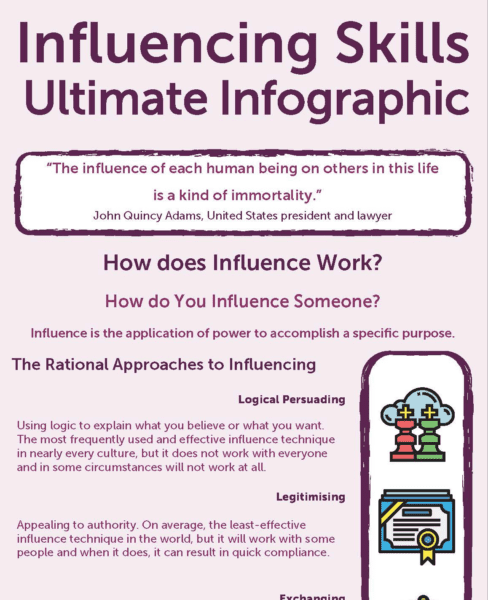
9) What is the Ability to Influence Others?
The ability to influence others is to use your personal skills to change another. The ability to change another’s behaviour, actions, motivations, or the effect itself is regularly occurring in the world. Simply put, you need to master the art of influence. Just as important, you need to recognise how YOU are influenced by others. Having a grasp on this will improve relationships and foster smarter decisions.
Harvard Business School Professor, Amy Cuddy, tells us that people judge you on two specific areas when they meet you:
- Can I trust this person?
- Can I respect this person?
The second question is viewed as competence in the person. In professional settings, people believe competence is first. However, you must win their trust before their respect.
Trust is won by showing warmth. You can do this through nonverbal cues such as smiling, nodding your head in agreement during conversations and staying present.

10) How Do You Influence Others?
Below are Leadership and Influencing Skills Examples of the 10 most effective ways to influence others:
- Build Trust: Understand the trust formula and use it positively.
- Storytelling: For thousands of years, we have been influenced by powerful stories.
- Lead by Example: Show others that you are willing to do what they might not be.
- Listen Actively: Know the push/pull method of influencing to influence people well.
- Praise: We are all made to feel special by praise. Do it more often.
- Be Empathetic: People want empathy because we all want our problems heard and understood.
- Assertive & Co-operative: Learn the Thomas-Kilmann model to manage conflict assertively and co-operatively.
- Body Language: Identify body language that gives you signs of what people are really saying.
- Small Words: Know the small words that let you know what people want. For example, when someone says that they are ‘not precious’ about something, they really are precious.
- Be Present: You can easily kill your influencing power by, for example, reading a text when someone is talking to you.
Click on the image below to open the full infographic on push and pull influencing model:
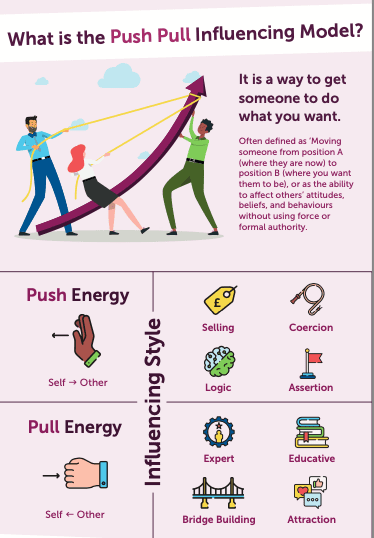
11) How Should You Influence at Work?
This world has big problems to solve that require collaboration. Collaboration requires communication. And both require interaction and a personal connection. This is just the start of companies sharing data and ideas.
Some call it a knowledge-sharing culture, while others refer to it as a learning culture. Either way, the result could have a tremendous reward for industries. That is if employees are encouraged to offer their skills and expertise.
If your organisation does not yet integrate this process then it is up to key change-makers. Showing up as both leader and change-maker requires a learning culture mindset.
As an Influencing Leader, You Should Use Your Skills in Influencing to Help Others:
- Share the knowledge and skills they possess, even outside their department. Helping others with support on a project or task is mutually beneficial.
- Reach out to offer help on projects. Employees and coworkers will be encouraged to help. It also makes you more valuable and versatile.
- Increase your exposure to others intending to learn added skills.
- Become a mentor.
12) Four-Step Method to Influence Others at Work
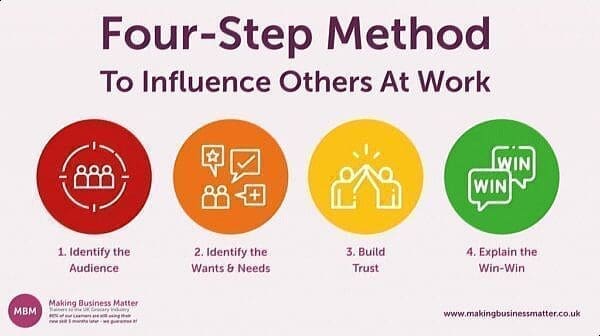
The Four-Step Method displayed above on how to influence others is easy to use. It applies to an individual or group, personal or professional. Consistency in using this process will help you from reverting to outdated methods of influence.
1. Identify the Audience
- Who do you need to influence? Weigh the variables such as differences in generation, knowledge of the project, culture, personality type, and other areas that cause an impact. Then choose the influencing leadership style that best fits the goals.
- Know who influences the project. Nurture those relationships with genuine interest.
Related reading: Goleman’s leadership style.
2. Identify the Wants and Needs
- People often lead with their own agenda and ideas when trying to influence others. This makes the request seem much more in favour of the requester even if it is mutually beneficial.
Therefore, you must practice perspective-taking. This means viewing the problem from the other person’s point of view. Think of all the ways it will affect them. This may involve time, money, loss of resources, etc.
- Use the Socratic method of asking a lot of questions to get more understanding.
- This information can help you form answers to expected questions and reactions.
3. Build Trust
Research continues to show it is imperative to create a connection before leading. This trust and connection happen when the person recognises these qualities in you:
- Commonalities – People trust others who are similar.
- Aligned interests – Find mutual commitments or common values.
- Benevolence – A genuine concern for others.
- Capability or Competence – The ability to deliver on your promises.
- Predictability and Integrity – Consistent trustworthy attitudes.
- Communication – Listen(s), hears other sides and are open to discussion.
4. Explain the Win-Win
- If you follow steps one, two and three, then you are certain to find a more receptive audience for step four. This is where reasoning comes in. Actually, reasoning is a key aspect or skill of persuasion. A technique of reasoning is to explain the advantages, give examples and show how the request ties to their needs.
- Here’s a commonly used technique of persuasion and reasoning. Let the person or group know how it will affect them if they DO NOT take action. Touching on pain points for NOT taking part can sometimes be as strong a motivator as if they DO take part.
Note that this should only focus on their ‘pain points’. This is something they are having trouble with. But intimidation or coercion should not be used.
Here is a Real-Life Workplace Influencing Skills Example:
John is the manufacturing manager for a large facility. Mary, who is in customer service, approaches John with a request to purchase inventory software. Mary knows that budgets are tight and John will have a concern for cost. Identifying your audience is an important part of influencing others in the workplace.
She knows that John prides himself on accuracy, being level-headed, and having excellent customer service. John is concerned about errors that are occurring with the current outdated system.
Mary has used persuasion skills to convince John to take action. John upgrades the current system. Mary has influence because of her approach. Her audience is John. She knows John’s demeanour and his areas of concern. She has answers to expected questions. Finally, she presents her case with logical reasoning.
13) What Influence is Important in Leadership?

Influencing Leaders act as a liaison between the greater good and ‘here is the vision to complete’. They inspire and motivate them to achieve outcomes beneficial to the majority.
There are countless definitions of leadership. To make it clear: leadership is an interpersonal process that uses influence. Influence uses power to bring about change.
We better say that again…
Influencing Leadership Uses Influence. Influence Uses Power
Power comes from several sources and should not be thought of as inherently bad. Remember, people in power can do great things! That is why organisations hire influencing leadership to promote change. And that change could be in the form of reducing costs or bringing a new product to market, etc.
The leader is influential in conveying the message and direction of the company. This is all while using influence to bring change.
- Therefore, emotional intelligence and awareness are required to identify personality traits and understand their audience.
- They need to be adaptable in their leadership style, exhibiting transformational leadership to meet the needs of many personalities and situations.
- They can show positive and assertive personal impact to get issues resolved productively. This may involve difficult conversations or negative feedback, but this information is given with respect and constructive intent.
- Leadership needs to give support and convey understanding. They should be reliable and empathetic to practice perspective-taking.
- An important influence of leadership is to be clear in communication and direction. Leaders provide clarity in ambiguous situations. Lack of clarity leads to confusion and frustration for everyone involved.
- Finally, they need to be trusted as honest, consistent, and transparent in their efforts. This allows for accurate information gathering.
14) How Can I Tell if Someone is Trying to Influence Me?
You probably already know when someone is trying to influence you. However, you may put a different label on it. For instance, sales, marketing, ideas, change, request, and brand. All of these functions can be mutually beneficial.
Let’s start with an example:
- You have just driven home in your new Mercedes-Benz A-Class. The marketing flyers influenced you to go to the dealership.
- The salesperson talked to you to identify their audience. You do not need a big car, you want a low payment, and fuel mileage is a concern.
- They did not try selling you the Mercedes-Benz S-Class. In their assessment, this vehicle would not meet your needs.
- After the test drive, the salesperson used persuasion skills and techniques to tailor the details and specifics to your needs.
At this point, you might think influence is getting someone else to do what you want. In part, that is right. However, it is not a one-sided relationship. Effective influence takes the other person’s perspective into account. This is important because it produces a win-win. Both individuals or groups get satisfaction from the exchange.
In the example above, the buyer got something they needed, a car. The salesperson got what they needed, payment. The salesperson did not use tactics of force or intimidation. The buyer was persuaded to buy. Thus, they had been influenced.
Positive vs. Negative Influence
With the car buying scenario, the influence, and the outcome were positive. Had the salesperson tried to sell the most expensive car, this would be a negative influence. The salesperson would influence the buyer because they want the largest sale. However, they would not have identified the audience or recognised the specific needs of the buyer.

Influence does not require a sale or agreement to be positive. A disagreement or no answer is not considered exclusively negative. Change or effect shows the influence.
It takes tremendous discipline to control the influence, the power you have over other people’s lives.”
– Clint Eastwood
15) How Persuasion Skills Relate to Skills in Influencing
We showed what influence means, the four-step process to influence others, and the skills needed to influence. It is just as valuable to grasp the relationship between persuasion skills as it relates to influence.
Persuasion skills centre on convincing another to act on something. Persuasion can conjure up the image of someone being talked into something. One may believe that being persuaded to do something appears weak and negative. And no one likes being talked into something that is not for their benefit.
Coercion Versus Persuasion
On the same note, coercion, and persuasion can be confusing. The contrast between the two is that coercion persuades someone to do something by using force or threats. Though the force need not be physical and threats need not be verbal.
For example, a CEO asks an entry-level employee for a special favour. The employee is intimidated by the level of authority. He feels pressure to say yes for fear of retaliation or loss of the job.
Someone could coerce someone else into doing something they don’t want to out of pressure or intimidation. Within the workplace, it is referred to as harassment. Coercion and harassment are forms of negative influence and are not tolerated.
Persuasion Can Be Positive and Beneficial
Have you ever convinced a friend to attend a wedding with you? Maybe you persuaded a police officer to let you out of a ticket? Persuasion is happening daily, to and by each one of us.
There is a science to influencing others and persuasion skills according to Dr Robert Cialdini, PhD. After years of studying persuasion techniques, Dr Cialdini states that positive persuasion increases when ethically using the principles below:

This happens because it is mentally taxing to make a decision. It takes time to weigh all options, so people take shortcuts.
As Displayed in the Visual Above, Their Decisions Are Based On:
- Reciprocity. People feel obligated to return a favour or invitation. So try to be the first to give.
- Scarcity. The thought that someone may no longer have access to something makes them want it more.
- Authority. People follow the lead of someone they think is in authority. This means you should promote your expertise beforehand. Note that a show of your credentials can increase your odds of success.
- Consistency. People want to be consistent. So look for voluntary, active and public commitments.
- Likeability Factor. People say yes to someone they like. And they like others who are similar and familiar. This can be done through genuine compliments and cooperation on mutual goals.
- Consensus. People look to others to determine their own actions. They want to go along with what others are doing.
More of Dr Cialdini’s research and interesting studies into persuasion skills can be found in his books mentioned at the end of this guide.
16) What Improves Your Influencing Others and Persuasion Skills?
Now you know just how much persuasion skill improvement you need. The next step is building these four qualities which form the foundation of your skills:
- The Listening Ability – Good influencing ability entails listening to what people want.
- Trust – If you don’t gain people’s trust you won’t influence their decisions.
- Likeable – If people like you, you can easily influence their decisions.
- Articulate Your Opinion – People who clearly articulate their opinion can easily influence others.
With these, you are on the road to being persuasive.
However, to be really good at influencing you need more. You need to know how to strengthen your self-awareness and inner confidence, understand the mechanics of body language and master the push and pull approaches.
Enhance Your Influencing and Persuasion Skills With iRascal:
Diplomacy is the art of letting someone else have your way.”
– Sir David Frost
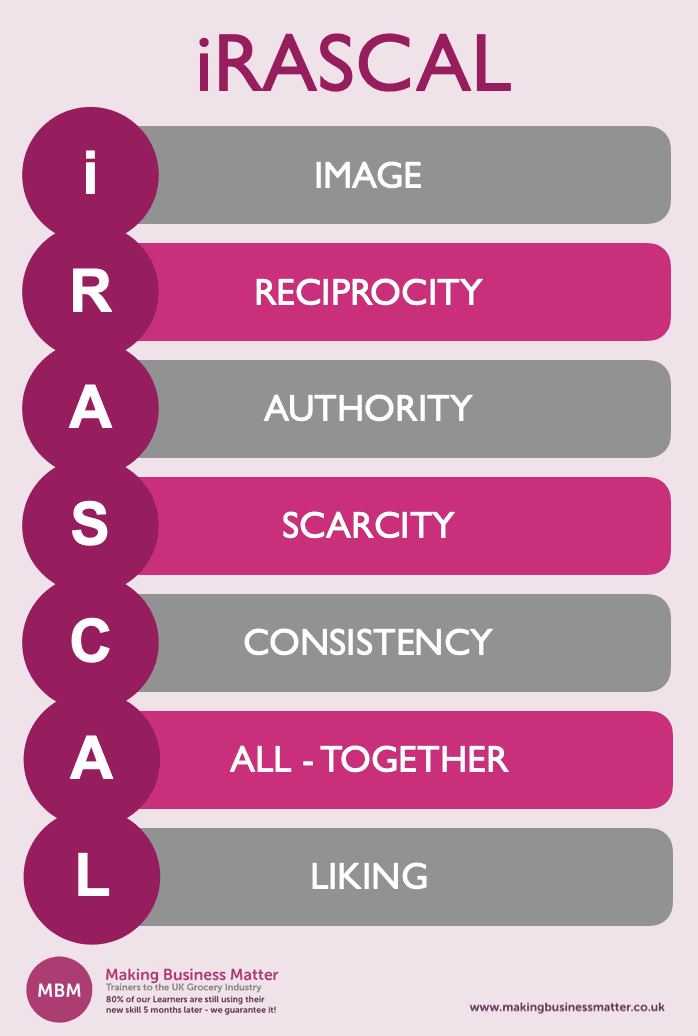
Excuse the Interruption, but Here’s a Little Bit About Us…
We are the soft skills training provider to the UK Grocery Industry, helping Suppliers to win more business. They choose us because of our money-back guarantee, our relevant experience, and because we make their learning stick.
Our unique training method, Sticky Learning ®, ensures that your Learners are still using their new skill 5 months later, and this is supported by a money-back guarantee.

17) Why We Fail to Influence
Raise your hand if you failed to influence this year. Most likely hands are not being raised. Firstly, the question is ambiguous and when people lack skills then it is difficult to admit.
Failing to influence can be subtle. With problems arising daily, leaders may not connect influence to the heart of a problem. Countless projects could be lost without pinpointing the lack of influence as the root cause.
Let’s make it easier to understand. Who would raise their hand if asked:
- How many of you had employee relations issues this year?
- Who here had a coworker or employee leave the company with dissatisfaction? How many people dread doing performance reviews or giving employee feedback?
- Who believes in building rapport before making a request?
Influence is Emotional. It Involves Connection and Rapport
Without those aspects, it is merely a transaction. Whether between two people or between businesses, rapport is still necessary.
Failing to influence in a personal or professional way is often because we don’t have the know-how. Influencing skills exercises are not taught in grade school and rarely in university. So to feel the void of sparse influencing skills exercises, use what you have learned throughout this guide to implement into your daily life.
When we attempt to influence, we use the only methods we know, saw or experience. When this doesn’t give us the desired result, we then resort to a different tactic and then another and another. More influencing skills exercises can be accessed through our training – more on this later.
All influence will give a result. Results that last and continue to inspire are from the positive influence and intrinsic motivation of the doer. Contrarily, results that come from negative influence rely on external motivation from the doer.
People are using intrinsic motivation when they are doing work for the sake of it being rewarding. Even if they receive a reward such as a paycheck. Extrinsic motivation is something you do when motivated by reward or punishment. Even though you might get the result, it won’t last for long unless the intent and influence are genuine.
18) Negative Ways of Persuasion and Influence

#1- Intimidation
This is frightening or threatening to get someone to do something you want. In fact, more laws are being passed to make these types of tactics unlawful in the workplace. Aldo, research shows we are more productive when we do things willingly. Intimidation through bullying and coercion is a quick way to demoralise and demotivate your staff.
#2- Nagging
Repeatedly reminding others about a task has the opposite effect of what is intended. As part of an effective method, determine if outstanding factors are leading to the delay in completion. Managers and Leaders may not realise where the root problem is occurring.
#3- Overrating Skills of Influence
Projects being completed can give the illusion that our persuasion skills are in top shape. But success in persuading and influencing can cause us to overlook our other skills and not improve.
#4- Being Overly Enthusiastic
Excessive enthusiasm is often synonymous with being erratic in your behaviour. Employees prefer a leader that is consistent with direction as opposed to directionless. The threshold for your enthusiasm varies with your audience. In particular, different cultures, and demographics exhibit varied expectations of etiquette, even in business setups.
#5- Talking Without Listening
This is creating your response before the other person finishes their sentence. But this shows that you did not consider the message entirely.
#6- Being Too Anxious
Some anxiety is normal. Too much of it, however, can make you look less confident. As you build confidence, you must note other people’s perceptions of your behaviour. Doing so will better your skills in influencing.
#7- Misunderstanding Our Audience
This is failing to gain perspective on the audience.
19) How Can You Gauge Your Level of Influence?
Click the image below for a greater resolution:

Aside from royalty, people are not born into power and influence. You may be surprised that the valuable skills of influence are learned traits that anyone can possess. Even more, this is regardless of your charm or title in the hierarchy.
Determine your influence on others by objective observation. Unfortunately, most of us are not objective when it comes to our strengths and weaknesses.
Research shows that leaders are more apt to tout their strengths and estimate their success as high. This is because they associate specific actions with positive business outcomes. For example, their excellent problem-solving skills saved the customer money and they won the contract.
Weaknesses, on the other hand, leaders see as inaction on their part. Inaction equates to failure and they are not readily interested in confronting this.
The same research states that leaders who are strong in one area may have a ‘fatal flaw’ in another area. Fatal flaws refer to major problems such as difficulty controlling temper. But if they score very low in one area and high in another, overall it still brings their competency down significantly.
What About Projects Getting Approved and Yes Votes From the Crowd?
Surely this must indicate that we have good skills and are competent at influencing. Sorry, but it doesn’t. Actually, influence is not always about getting approval. The approval could likely be contingent upon outside factors and not a good indicator. Being open to an idea or willing to discuss it can also be seen as a win.
If you are in a position of authority, then you likely have taken part in assessments such as employee feedback surveys. These surveys can fall short when indicating how you lead and connect to staff and coworkers. Therefore it is up to you to find ways of evaluation and adjustment. Just like any continuous improvement, you cannot depend on an organisation to determine your personal improvement.
Thankfully, MBM has an incredible tool for assessing thinking patterns, which is a direct connection to how you influence. Take a look at our HBDI Ultimate Guide to find out more.
The 120-question HBDI survey measures preferences as opposed to skills. Also, it isn’t a test since there are no right or wrong answers. And it can be used for individuals or teams.
The Survey Will Show Your Preference for One of the Following Ways (It Also Assesses Variations in Stressful Times):
- Fact – Logical, technical and financial.
- Form – Organised detailed and structured.
- Feeling – Emotional, sensory and people.
- Future – Risk-taker, intuitive and big picture.
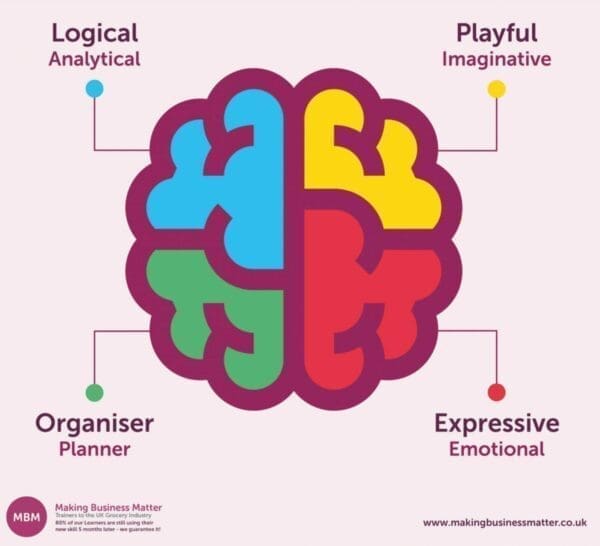
By understanding how people think, we can more accurately gauge their motivations, abilities, personalities and many other attributes. These attributes are critical steps toward effective persuasion and influencing skills. Hence, the tool can be very helpful in the management of human resources.
20) So, How Do You Improve Your Level of Influence?
- Ask for honest feedback. Be certain that you let people know you would like honest feedback because you intend to improve. Outside of a survey, coworkers, and employees can be reluctant to be open and honest. Human resources and close friends are more willing to offer constructive criticism if you specifically ask.
- Specific assessment testing can give an eye-opening picture for you to work from. You can’t fix what you don’t think is broken.
- In authority or not, you must become self-aware. Self-awareness is knowing yourself, how you react in certain situations, traits, areas to improve, qualities, etc. It also considers how you perceive yourself and your interactions with others. This is key to using your influence.
- Practice. Every day can be an opportunity for practising your interactions and connections with coworkers and even strangers.
- Learn to adjust your approach with different personalities to mimic transformational leadership.
21) The Future of Skills in Influencing
Work is no longer performed like it was ten, twenty or one hundred years ago. Historically, influence and influencing skills have centred on title and authority as the decision-maker. When given an order, you were expected to abide without input. A one-sided process using intimidation or coercion to get a job done was commonplace.
Now long before studies showed more effective ways to influence, there were internal cues. These cues indicated that an autocratic process of influence was not working. Specifically, high levels of turnover from dissatisfied employees. And people leave a company to find a less unruly boss, which has been mainstream for years.
To stem the loss of knowledge and reduce costly turnover, organisations made attempts to identify problem areas. Fast forward many years there is a new revelation of work. It’s purpose-driven with new styles of leadership producing new ideas.
We are close to understanding how to create a workplace that benefits the company and the employee.
A company that benefits employees and leadership is important. People want to be collaborative, appreciated, and know that their ideas matter. Companies and leaders now realise the value of recognising and appreciating the skills of others.
With this future-focused workplace becoming more employee-centred, everyone has opportunities to showcase their ideas. So it is time to make a real difference.
True leaders bring out your personal best. They ignite your human potential.”
– John Paul Warren
22) Summary & Key Insights
Developing your influencing skills is an investment worth your time, effort and money. It becomes more necessary as you advance in your career or business venture. Our influencing skills training page will provide more guidance.
All this might seem a lot to absorb and even too much to recall. However, the key is to regularly put it into practice so it becomes part of your daily routine. That’s the key principle behind the Sticky Learning process. It turns these concepts from mental lessons into lifetime personal behaviours.
So, in Summary, Ensure You Do the Following to Improve Your Skills in Influencing:
- First, let people know your abilities and qualifications, but don’t overemphasise your successes.
- Show genuine interest in others, but don’t overdo it; otherwise, it will appear phoney.
- Make sure your presence is rewarding to those around you, but don’t hog the limelight.
- Remember to smile, but not just when others are smiling back at you.
- Yes, do correct people when they go wrong, but don’t be too judgemental.
- Prove that you’re always reliable, but don’t take more responsibility than you can handle.
- Learn to assert yourself without being overly aggressive, which could ruin long-term relationships.
- Be flexible and open to new experiences, but don’t lose your authentic self.
- Develop close personal relationships without intruding where you shouldn’t.
- Take more action than words, but don’t neglect the power of your words.
- Don’t always react to situations; instead, prepare beforehand how you’ll handle unexpected events.
- Constantly evaluate the impact you have and make changes where necessary.
- Finally, don’t rely only on your own capacity, but build a strong network of influencers.
At times, you might assume your words have made an impact, yet they haven’t. Just so you can be sure of the impact you actually have, you should know how to get a better read on people:
- Avoid confirmation bias – People often focus on aspects confirming their biased perceptions. To avoid this, always be open to revising your initial judgements about others.
- Be aware of the influence other people have on you – As you seek to persuade others, many more are trying to do the same to you. Also, notice the incredible amount of external stimuli in this modern advert-filled life. You’ll surely need some time off once in a while.
Lastly…
We hope that you take the time to evaluate and improve your communication and influencing skills in this article. It just might be the best set of skills you didn’t know you were missing.
23) Further Reading & Resources
You can find further insight, detailed definitions and clarification of all the key skills in influencing terms mentioned in this guide in our Glossary of Terms.
#1 – Books
First of all, the following books are some of our favourites on influencing skills. All in all, they will help you further your knowledge and understanding of influencing and persuasion skills and are full of lots of useful tools, skills in influencing tips and influencing skills training ideas that you can put into practice.

- How to Win Friends & Influence People by Dale Carnegie.
- Influence: The Psychology of Persuasion by Robert Cialdini.
- Key Person of Influence by Daniel Priestley.
- Pre-Suasion: A Revolutionary Way to Influence and Persuade by Robert Cialdini.
- The Pin Drop Principle by David Lewis and G. Riley Mills.
Additionally, you can find more of our recommended reading for self-improvement in our Best Self Help Books post on our blog– these will provide even more useful tips.
#2- Videos
Then, subscribe to our YouTube Channel. For starters, you can get a preview by starting with our playlist on Influencing Skills Training and Tips (below):




